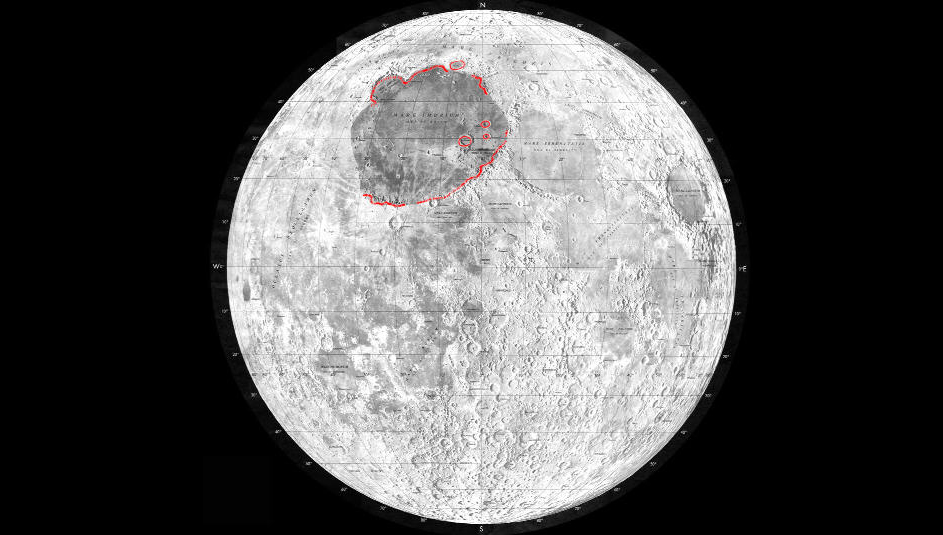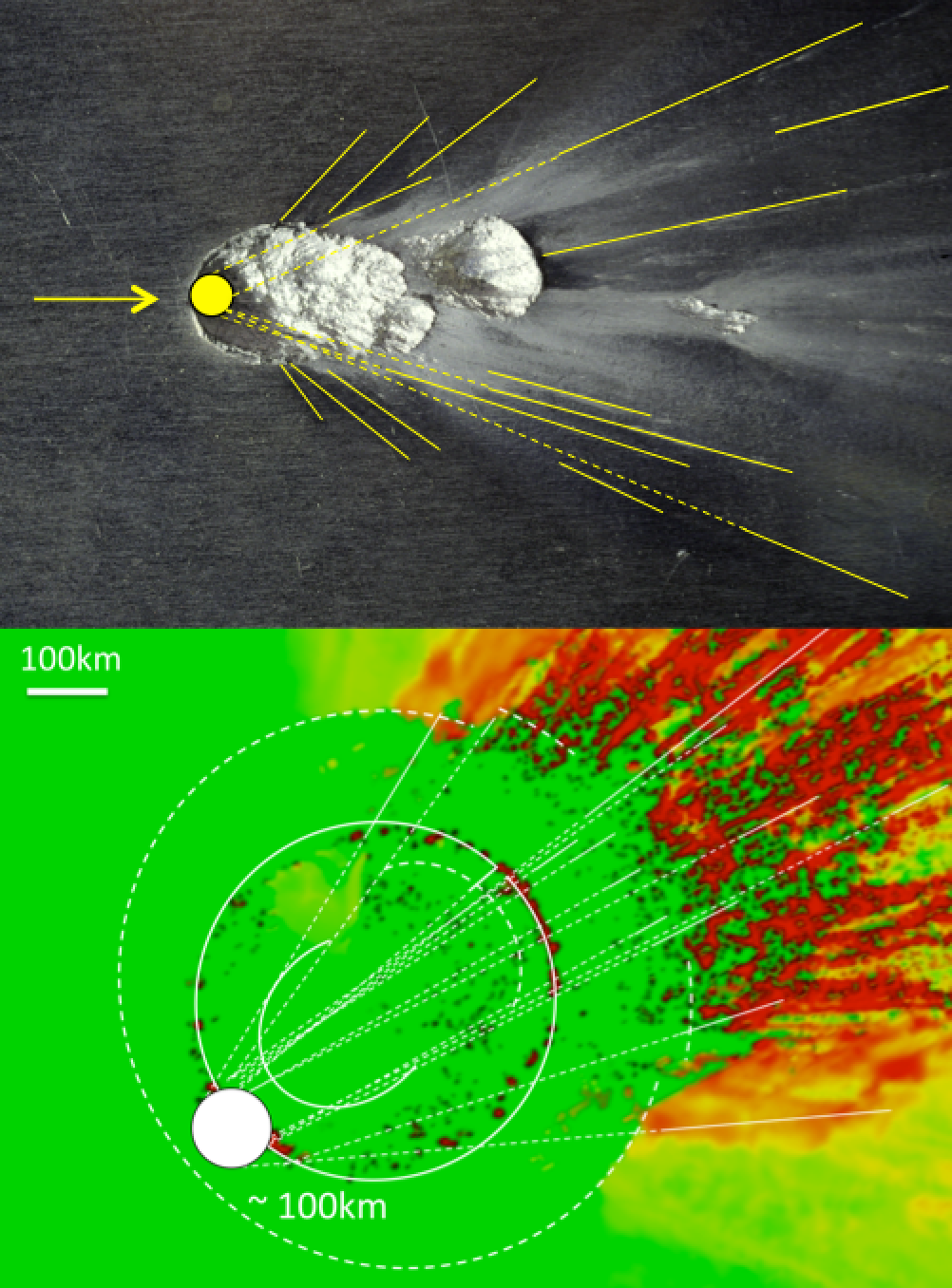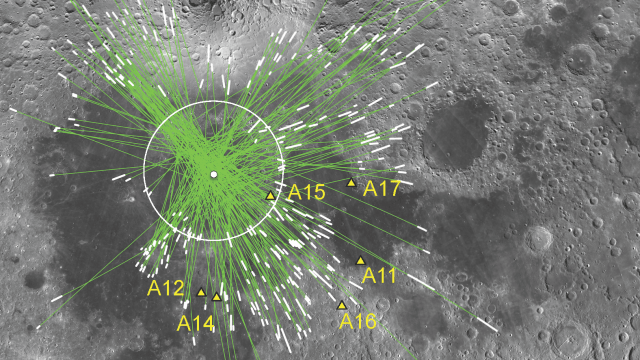Four billion years ago, an endless barrage of space rock pummelled the surface of the Earth and the Moon, in a period known as the Late Heavy Bombardment. Now, astronomers have performed a detailed analysis of one of the most famous craters from that time, and what they have learned could rewrite the most violent chapter in Earth’s history.
Trajectories of debris (green) ejected from Imbrium basin and forming scars on the Moon’s surface. One set converges on the centre, another does not. Image: Peter Schultz
Imbrium basin, better known as the man in the moon’s right eye, was punched out by an enormous object — a protoplanet roughly the size of New Jersey. According to research published in today’s Nature, that impactor was so big that as it broke up, it sent chunks of debris spewing in all directions, helping fuel the 200-million year-long hard rain. And there could have been many other protoplanetary impacts like it.
“Previous models estimated that this asteroid was maybe 80km across,” lead study author Peter Schultz of Brown University told Gizmodo. “We’re talking something at least 250km across. And that is a conservative estimate.”

Location of Imbrium basin. Image: Wikimedia
A dark depression some 1200km wide, Imbrium basin is one of the most striking impact craters in our solar system. Clearly visible with the aid of a backyard telescope, it’s been the subject of intense scrutiny by professional and amateur astronomers alike.
Among the basin’s more prominent features are a series of gashes that emanate radially outward, like spokes on a wheel. These were created by rocks blasted from the crater when it was formed, and they are concentrated on the basin’s southeastern side, suggesting that the impact came from the northwest.
But those who’ve stared deep into the moon man’s eye have noticed something else: Another set of landscape scars that do not converge on the crater’s centre. “Way back in the ’50s and ’60s, astronomers couldn’t figure out why these features were there,” Schultz said. “It’s been a curiosity for a long, long time.”
Now, Schultz appears to have solved the mystery and shed new light on the nature of the Late Heavy Bombardment. He did so in a manner keeping with the spirit of ancient geologic times: By shooting projectiles at hypersonic speeds out of a giant cannon.

Comparison of scouring marks produced in experiments (top) and those produced in a computational model of a 100 km-wide object. Image: Peter Schultz
“It’s a three storey tall gun at NASA Ames that was created during the Apollo program to understand the nature of the lunar surface,” Schultz explained, referring to the Vertical Gun Range he used to simulate collisions. “It fires small projectiles at six to seven kilometres per second. What this does is reveal [dynamics] you can’t recreate with a slingshot, because the objects are going so fast that they let off strong shockwaves.”
Using a high speed camera to record the simulated impacts, Schultz discovered that chunks of material break off up-range of the main crater. These rocks will continue to travel at high speeds, scouring the impact crater’s surface in a non-radial fashion. Pairing this observations with computer models, Schultz and his colleagues were able to show that the same physics works out on the much larger scale of a lunar impact.
Having solved the mystery of Imbrium basin’s non-radial scars, Schultz realised something else: That these features could be used to estimate the assaulting space rock’s girth. According to his calculations, it was about 10 times more massive than astronomers previously thought.
In fact, the impactor was large enough to be considered a protoplanet — an object rounded by its own gravity and featuring signs of differentiation. A similar analysis of the Moon’s Moscoviense and Orientale basins revealed that these craters, too, were probably caused by protoplanet-sized collisions.
The discovery adds a new twist to the Late Heavy Bombardment, which astronomers have long theorised to be the result of numerous small objects swept into our cosmic backyard from the asteroid and Kuiper belts. The cratering record on Mercury suggests that a vast swath of the inner solar system was impacted during this time.
“We’re not claiming the entire Late Heavy Bombardment was from protoplanets — other asteroids were going bump in the night as well,” Schultz said. “But this paper does suggest there were a lot of large protoplanets roaming the inner solar system.”
By modelling what happened after Imbrium basin formed, Schultz and his co-authors showed that protoplanetary impacts could have been responsible for many small craters, as well. The initial impact sent thousands of chunks of debris flying in all directions, and some of these would have eventually rained back down. “It’s like shrapnel ripping off and coming back to hit us again and again,” Schultz said.
Schultz is now applying his methods to other cratered worlds, including Mercury and Mars. If his hunch about the Late Heavy Bombardment is correct, there should plenty more signs of an ancient planetary turf war waiting to be discovered.
